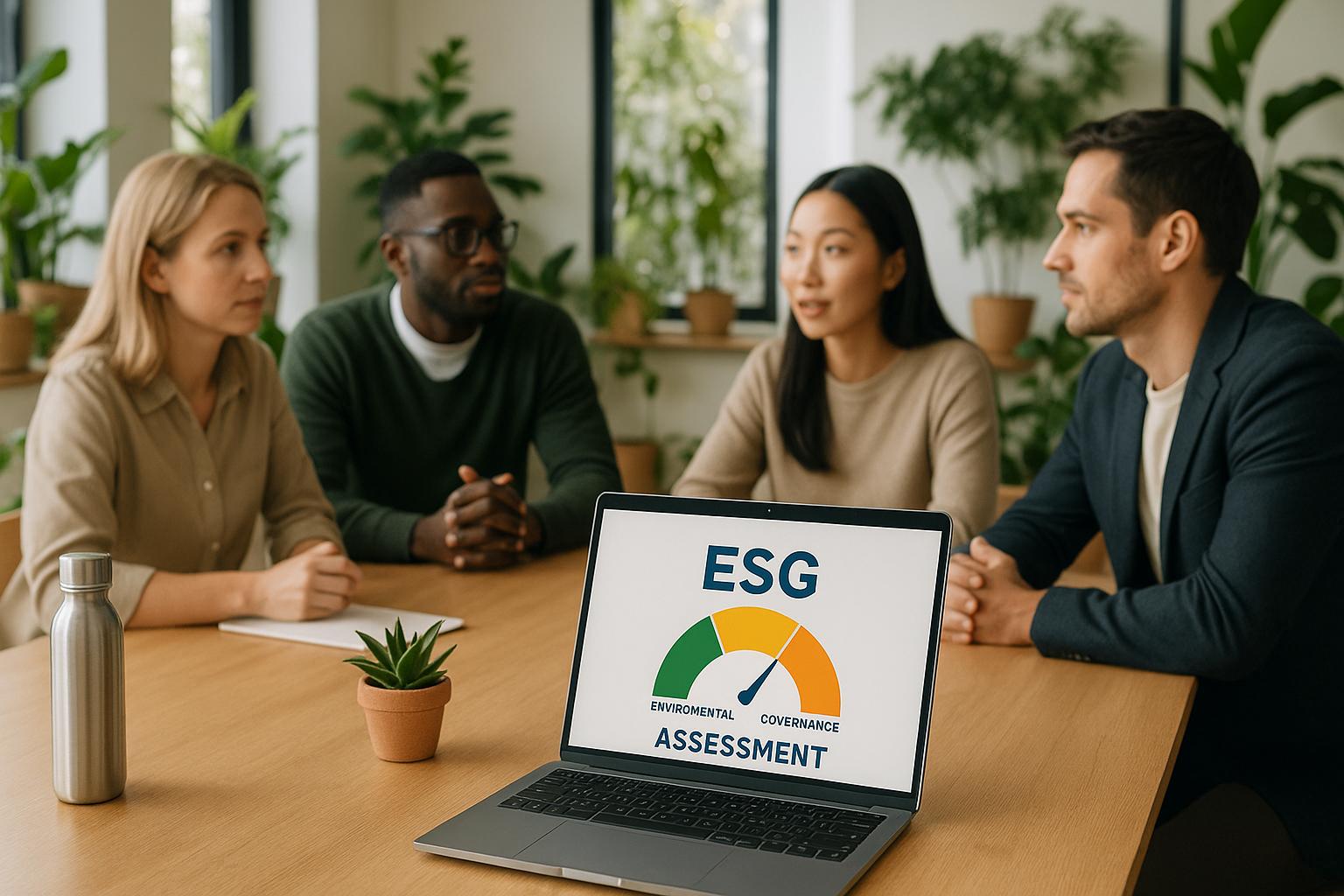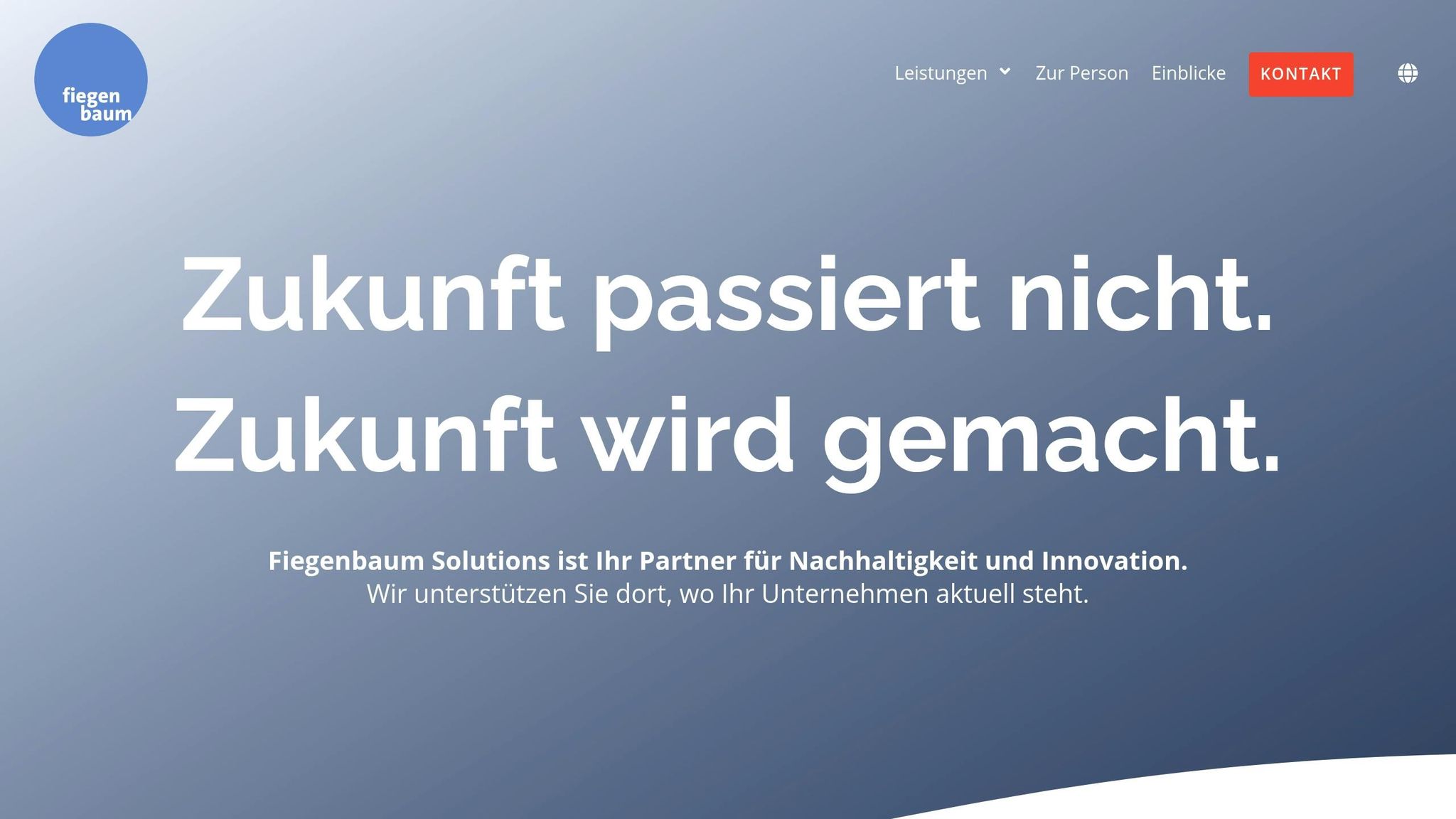How to Identify and Manage Hidden Climate Risks in Your Supply Chain
How well do you know the climate risks in your supply chain? Hidden climate exposures—risks that...
By: Johannes Fiegenbaum on 7/31/25 3:33 PM

How sustainable is your company? By taking a clear look at the ESG areas—Environment, Social, and Governance, you can assess your sustainability performance and make targeted improvements. The EU is tightening reporting requirements: Starting in 2025, the CSRD will affect up to 50,000 companies. Early self-assessment is therefore crucial to meet legal requirements and secure your competitiveness, especially as global investor expectations for ESG transparency continue to rise (source).
With a structured checklist and clear objectives, you can effectively shape your ESG strategy. Use proven standards such as the GRI or the German Sustainability Code to make progress measurable and build trust. According to KPMG’s 2022 Survey of Sustainability Reporting, 96% of the world’s largest companies now report on sustainability, underscoring the growing importance of standardized ESG frameworks (source).
To conduct a meaningful ESG assessment, it’s important to systematically analyze the three core areas—environment, social, and governance. Each pillar brings unique challenges and opportunities, and a holistic approach is essential for long-term success.
The environmental area focuses on how your company impacts the environment. A central point is resource efficiency: How efficiently are energy, water, and raw materials used? In Germany, there has already been significant progress: Over 70% of companies know their CO₂ footprint, and around 54% have set concrete targets to reduce their emissions (source).
Another focus is greenhouse gas emissions, divided into Scope 1 (direct emissions), Scope 2 (indirect emissions from purchased energy), and Scope 3 (all other indirect emissions along the value chain). A good example of ambitious action is Lidl: The company reduced its Scope 2 emissions by 97.4% by switching entirely to green electricity.
Waste management and circular economy are also playing an increasingly important role. The focus here is on avoiding, reusing, and recycling waste. Mercedes-Benz demonstrates what ambitious targets can look like: In 2022, the company achieved CO₂ neutrality at its vehicle production sites and plans to reduce emissions by 80% by 2030 (source).
An often overlooked but critical point is climate adaptation. How are you preparing for climate-related risks? The EU Taxonomy regulation provides helpful guidance to determine whether economic activities can be classified as environmentally sustainable. The European Environment Agency highlights that climate adaptation is increasingly vital as extreme weather events become more frequent (source).
After assessing your environmental performance, you can turn to the social impacts of your actions.
The social area deals with your company’s impact on people—both inside and outside the organization. Employee satisfaction is a key indicator here. Regular surveys and feedback mechanisms help measure and specifically improve workforce well-being. According to Gallup’s State of the Global Workplace 2023 report, companies with high employee engagement are 23% more profitable (source).
Diversity and inclusion are also important aspects. Companies should track diversity metrics such as gender and ethnic distribution to promote equal opportunity and an inclusive work environment. Interestingly, studies show that companies with diverse boards often achieve better financial results and act more creatively (source).
Another measurable area is philanthropic contributions. This is not just about the amount donated or volunteer hours, but also the actual impact on areas such as education, healthcare, or the development of local communities. The sustainability of suppliers is also moving into focus. Companies must ensure their supply chains are responsibly managed by evaluating the environmental and social standards of their partners. The German Supply Chain Act (Lieferkettengesetz) underscores the importance of due diligence in supply chains (source).
Alongside environment and social, governance is a crucial component of a comprehensive ESG assessment. Good governance is characterized by transparency, accountability, and long-term value creation. Board composition is a central point: Companies should report on the diversity of their leadership bodies—whether in terms of gender, background, or experience.
An exciting trend is the linking of executive compensation to ESG goals. For example, Unilever has tied part of its executives’ bonuses to progress on sustainability targets. This ensures that ESG is not just a paper priority but is actively driven forward (source).
Anti-corruption measures and compliance with legal requirements are essential to gain stakeholder trust. Companies should transparently disclose which processes they have implemented to prevent fraud and promote ethical conduct at all levels.
Another key point is stakeholder engagement. Regular materiality analyses help identify topics that are relevant both to stakeholders and to company performance. Yet a survey shows that while 88% of executives emphasize the importance of CSR and ESG reporting, only 37% feel confident with their current measurement approach (source).
A structured checklist can help you specifically assess your company’s sustainability performance. A good starting point is established standards: 73% of the world’s 250 largest companies use the GRI standard to monitor their sustainability goals (source).
Why is this important? Measuring sustainability metrics allows you to document progress, evaluate actions, and strengthen stakeholder trust. Below you’ll find practical approaches—from environmental metrics to governance indicators—that you can apply directly to your business reality.
To capture your company’s environmental footprint, collaboration with various departments is essential. Analyze electricity bills, waste logs, and transport data.
Energy consumption and emissions:
Determine total energy consumption in kilowatt-hours (kWh) and calculate energy intensity per production unit. Document the share of renewable energy as a percentage and measure your CO₂ footprint in tons of CO₂ equivalent.
Siemens was able to reduce its emissions by 46% after investing over 650 million euros in CO₂ reduction measures (source).
Water and waste management:
Record water consumption in cubic meters per production unit and the share of treated wastewater. Document waste quantities (in kilograms per production unit) as well as recycling and composting rates. Also, be sure to track the proportion of recycled materials in your products.
Supply chain and materials:
Assess material input efficiency (MIPS) and identify critical suppliers and risk categories. Ensure your suppliers comply with environmental standards.
Once you have fully captured your environmental metrics, you can turn to the social dimension.
A company’s social responsibility requires close cooperation with HR and regular surveys of your stakeholders.
Companies that actively involve their employees in CSR activities report a 20% increase in productivity (source).
Employee well-being:
Conduct regular satisfaction surveys and analyze turnover rates. Track training hours per employee as well as workplace accidents and sick days.
Diversity and inclusion:
Document gender distribution in leadership positions and ethnic diversity within the company. Measure pay equity between different groups and conduct inclusion surveys.
Community engagement:
Record philanthropic contributions in euros and document your employees’ volunteer hours.
70% of consumers prefer brands that are committed to sustainability (source).
Assess the impact of your initiatives on areas such as education, healthcare, or the development of local communities.
Stakeholder feedback:
Actively collect feedback from employees, customers, and community members—this is crucial for improving your CSR strategies. Modern technologies can support you in data collection and analysis.
Good corporate governance strengthens decision-making, promotes ethical behavior, and builds trust.
More than half of business leaders believe that ESG factors lead to better decisions (source).
Board structure and diversity:
Document your board’s composition in terms of gender, background, and experience. Develop policies for diversity and inclusion and measure the independence and ESG expertise of board members.
Compensation and incentive systems:
Ensure that executive compensation is linked to long-term stakeholder interests. Track what portion of compensation is tied to ESG goals.
Transparency and compliance:
For institutional investors, anti-corruption is the most important ESG topic—even ahead of climate change and shareholder rights (source).
Implement anti-corruption programs, whistleblowing mechanisms, and training to promote ethical conduct.
Stakeholder rights:
Ensure that shareholders are heard through engagement processes and voting rights. Develop an ESG reporting strategy and use various channels to communicate your results transparently.
After completing your ESG checklist, it’s time to systematically evaluate your results. ESG scores provide a measurable basis for assessing your company’s performance in the areas of environment, social, and governance. They help you better understand and specifically improve your commitment to sustainable business practices. This analysis not only highlights your strengths and weaknesses but also lays the foundation for concrete improvement measures that can convince investors, strengthen your reputation, and foster sustainable growth in the long term.
The checklist is a valuable tool for clearly identifying weaknesses. Start with a risk analysis and assess which actions could improve your ESG score. Compare key indicators such as energy consumption, CO₂ emissions, and waste volumes with your industry’s benchmarks. Interestingly, supply chains often account for more than 80% of a company’s total environmental impact—a field with significant optimization potential (source).
To make progress, it’s best to develop an action plan with clear goals, fixed deadlines, and defined responsibilities. Companies like Microsoft and Adidas show what ambitious targets can look like: Microsoft aims to be carbon negative by 2030 (source), while Adidas plans to use only recycled polyester in its products by 2024 (source). Prioritize your actions based on their impact and feasibility, and establish mechanisms to regularly monitor progress.
A comparison matrix is a helpful tool for systematically evaluating identified gaps. It helps you objectively classify your ESG performance and determine your position within the industry. Also, engage in discussions with your stakeholders to better understand their expectations regarding ESG topics. After all, 89% of global investors want ESG reports based on uniform standards (source).
Collect relevant ESG data and compare it with industry standards to identify concrete improvement opportunities. Set SMART goals—specific, measurable, achievable, relevant, and time-bound—and create detailed plans with clear timelines, budgets, and responsibilities. Ongoing monitoring and regular reporting on your progress are crucial to adapt your ESG strategies to new regulations, technological developments, and stakeholder expectations.
In the end, solid ESG performance metrics can not only strengthen your credibility but also help you avoid accusations of greenwashing.
Your ESG analysis is the first step—but to achieve real progress, you need the right tools and support. With the right frameworks, software solutions, and consulting services, you can ensure your actions deliver measurable results, not just surface-level changes.
Especially for getting started, established standards such as the Global Reporting Initiative (GRI) and the German Sustainability Code (DNK) are recommended. The DNK, a voluntary transparency standard from the German Council for Sustainable Development, covers 20 criteria in the areas of strategy, process management, environment, and society.
Another important tool is the EU Taxonomy, which has applied to the environmental goals of climate protection and climate adaptation since January 2022. It scientifically defines which economic activities are considered environmentally sustainable. Sustainability expert Quentin Hennaux describes its objective as follows:
"Any company can say they are sustainable, but the EU Taxonomy intends to provide stakeholders with appropriate definitions for which activities can be considered environmentally sustainable thanks to science-based criteria."
Additionally, the European Sustainability Reporting Standards (ESRS) play a central role. They are based on frameworks such as CDP, GRI, and SASB and include over 140 sustainability indicators that companies must capture and disclose. Whether you publish this information in your management report or a separate sustainability report is up to you.
These standards form the basis for specialized software solutions, such as those offered by Fiegenbaum Solutions.

ESG software simplifies the collection, analysis, and reporting of your ESG data. It not only ensures more accurate data but also guarantees compliance with relevant standards. When selecting such tools, look for features such as automated data collection, calculation modules, framework integration, analytics functions, and user-friendliness. Costs usually depend on company size, feature set, and data volume, and are often offered on a subscription basis.
Fiegenbaum Solutions also provides comprehensive consulting—from impact analysis to the development of long-term ESG strategies. Johannes Fiegenbaum brings not only regulatory expertise but also practical market insights and entrepreneurial thinking to help you implement measurable and future-proof actions.
The consulting offering ranges from project-based solutions, such as life cycle analyses or ESG roadmaps, to retainer models for ongoing support. Special terms are available for startups, taking into account the often limited resources in the early stages.
Many companies turn to external ESG consultants when internal resources or the necessary expertise are lacking to meet the complex requirements of ESG regulations and reporting frameworks. The German market for sustainability consulting is growing rapidly: In 2024, the volume was $1.2 billion and is expected to rise to $2.2 billion by 2033—with an annual growth rate of 8.4% (source).
Professional support is especially helpful when it comes to developing targeted strategies that lead to concrete, measurable results. Smaller companies also benefit from simplified standards: In December 2024, EFRAG introduced voluntary reporting standards specifically for SMEs to make it easier to get started. At the same time, the EU Omnibus Regulation aims to reduce reporting requirements by 25% without changing the essential elements of the frameworks.
These developments show how important it is to select the right tools and consulting services early on to benefit from streamlined processes and clear guidelines. A structured approach can be crucial for success in a rapidly changing regulatory environment.
The ESG quick check is complete—now it’s time to turn your insights into concrete actions. Your analysis of the environment, social, and governance areas has shown where your company currently stands and which fields still offer room for development. These results form the foundation for your next steps.
A sensible next step is to conduct a double materiality analysis. This allows you to systematically capture and prioritize your company’s environmental impacts and social influences. This approach is not only relevant for CSRD reporting but also helps you focus your resources on the most important ESG topics.
Align your actions with the six environmental goals of the EU Taxonomy: climate protection, adaptation to climate change, sustainable use of water and marine resources, transition to a circular economy, prevention and reduction of environmental pollution, and protection and restoration of biodiversity. These goals provide a clear framework for structuring your sustainability strategy.
At the same time, you should systematically collect and continuously monitor your data. This includes relevant climate and employee metrics, which should be regularly updated and reviewed. On average, companies report aligning 10% of revenue, 16% of capital expenditures (CapEx), and 12% of operating expenses (OpEx) with the EU Taxonomy (source). These benchmarks can help you better assess and classify your progress.
Also, carefully document your due diligence and corrective actions to comply with the OECD Guidelines, UN Guiding Principles, and ILO Core Labor Standards.
“The EU Taxonomy is a pioneering framework designed to promote sustainable investments and support the ambitious climate goals of the European Union as part of the European Green Deal.”
You can use this system as a guide for your long-term strategy.
Start with measures that can be implemented quickly and without major investment. At the same time, create a roadmap for more complex projects that require technical adjustments to meet the EU Taxonomy criteria.
In total, up to 50,000 companies are affected by the CSRD. Use tools and consulting to turn your self-assessment into a future-proof and effective sustainability strategy.

ESG & sustainability consultant specializing in CSRD, VSME, and climate risk analysis. 300+ projects for companies like Commerzbank, UBS, and Allianz.
More aboutHow well do you know the climate risks in your supply chain? Hidden climate exposures—risks that...
More and more companies in Germany are directly linking bonuses to CO₂ reduction targets. Why?...
Sustainability in the supply chain is no longer optional—it’s a legal obligation. With the Supply...